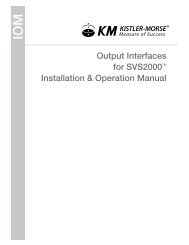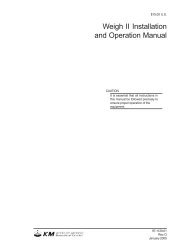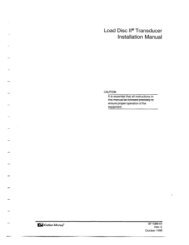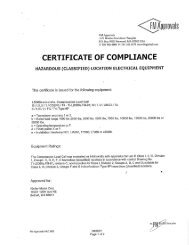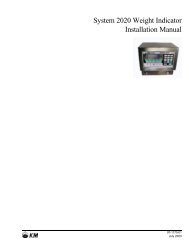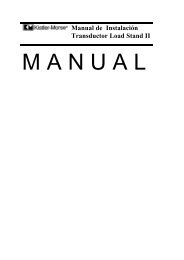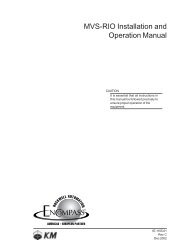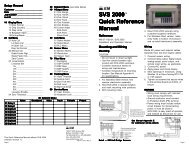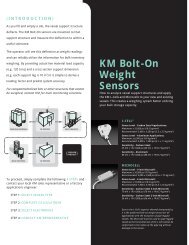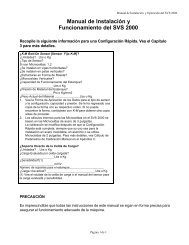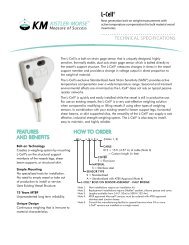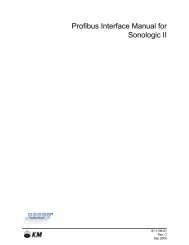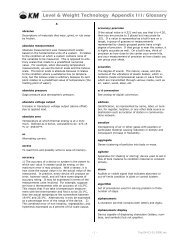STX Signal Transmitter Installation and Operation ... - Kistler-Morse
STX Signal Transmitter Installation and Operation ... - Kistler-Morse
STX Signal Transmitter Installation and Operation ... - Kistler-Morse
Create successful ePaper yourself
Turn your PDF publications into a flip-book with our unique Google optimized e-Paper software.
Chapter 3. St<strong>and</strong>-Alone <strong>STX</strong> Analog Calibration <strong>and</strong> Setup<br />
Refer to Table 3-11 for the positions of DS1<br />
through DS8 <strong>and</strong> then follow the procedure<br />
in Setting Up the Parameter. Note that the<br />
excitation voltages shown in the table are<br />
under nominal line conditions.<br />
DS4 DS3 DS2 DS1 Excitation Volts<br />
0 0 0 0 12.5<br />
0 0 0 1 12*<br />
0 0 1 0 11.5<br />
0 0 1 1 11<br />
0 1 0 0 10.5<br />
0 1 0 1 10<br />
0 1 1 0 9.5<br />
0 1 1 1 9<br />
1 0 0 0 8.5<br />
1 0 0 1 8<br />
1 0 1 0 7.5<br />
1 0 1 1 7<br />
1 1 0 0 6.5<br />
1 1 0 1 6<br />
1 1 1 0 5.5<br />
1 1 1 1 5<br />
1 = on, 0 = off, * = default<br />
Note: To select Excitation Voltage, set dipswitches DS5<br />
through DS8: DS8 = 1, DS7 = 0, DS6 = 0, DS5 = 0.<br />
Table 3-11. Excitation Voltage<br />
Dipswitch Settings<br />
DSP Filter<br />
Vibrations in a vessel can cause changes in<br />
the <strong>STX</strong>’s output, even though no material is<br />
moved, because the vibrations affect the<br />
vessel’s structural response. The Sentry<br />
DSP Filter reduces output changes that can<br />
result from vibration. The principle behind<br />
the filtering follows.<br />
The A/D converter digitizes the signal<br />
coming from a sensor. The <strong>STX</strong> picks the<br />
first signal as a reference median; this value<br />
is used in calculating the output. As shown in<br />
Figure 3-4, the <strong>STX</strong> then compares following<br />
signals to the reference median, <strong>and</strong> recalculates<br />
the reference median when either of<br />
the following happen:<br />
• the number of successive signals above<br />
or below the median exceeds a<br />
triggering number<br />
• a signal falls outside a user-defined<br />
window around the reference median<br />
When the <strong>STX</strong> recalculates the reference<br />
median, the transmitted data changes to<br />
correspond to the new reference median.<br />
The DSP Filter affects the <strong>STX</strong>’s current<br />
output as well as serial output to an MVS or<br />
other serial device.<br />
The DSP Filter has four parameters to define<br />
its operation: Filter On/Off, DSP Factor, Filter<br />
Step, <strong>and</strong> Qualify Factor.<br />
Filter On/Off<br />
This turns the DSP filter on <strong>and</strong> off.<br />
Refer to Table 3-12 for the positions of DS1<br />
through DS8 <strong>and</strong> then follow the procedure<br />
in Setting Up the Parameter.<br />
DS4 DS3 DS2 DS1 Filter On/Off<br />
x x x 0 On<br />
x x x 1 Off*<br />
1 = on, 0 = off, x = does not matter, * = default<br />
Note: To select Filter On/Off, set dipswitches DS5<br />
through DS8: DS8 = 1, DS7 = 0, DS6 = 0, DS5 = 1.<br />
Table 3-12. DSP Filter<br />
On/Off Dipswitch Settings<br />
Counts<br />
<strong>Signal</strong> falls outside of<br />
Filter Step envelope<br />
Counts<br />
3rd successive signal on<br />
same side of median<br />
Reference<br />
Median<br />
Filter<br />
Step<br />
Filter<br />
Step<br />
New median = last signal<br />
New median = ref median<br />
+ 0.8 x (ref median - last signal)<br />
Raw Counts<br />
Corrected Counts<br />
Example 1 — Qualify Factor =3,<br />
DSP Factor =80% (0.80)<br />
Time<br />
Figure 3-4. DSP Filter Examples<br />
3-9<br />
Example 2 — Qualify Factor =3,<br />
DSP Factor =80% (0.80)<br />
Time



